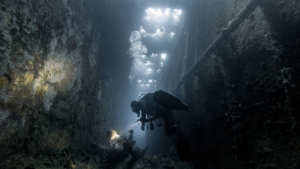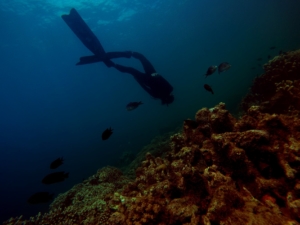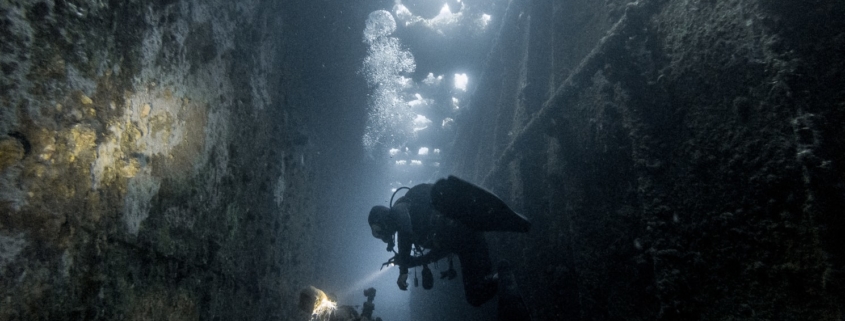How long do you stay underwater during a typical dive? Regardless of where you are diving, you’ll probably want to spend a decent amount of time exploring the aquatic environment. From fish and octopuses to coral reefs and sunken man-made structures, there’s a whole new world waiting for you below the surface. To fully explore it, though, you’ll need to extend your bottom time.
What Is Bottom Time?
 Recorded in most dive logs, bottom time refers to the total length of time a diver stays underwater. The Professional Association of Diving Instructors (PADI) defines the term “bottom time” as being the total elapsed time from descent to ascent. To calculate your bottom time, you count the minutes and seconds that you stay underwater, beginning from when you splash into the water and ending when you return to the surface.
Recorded in most dive logs, bottom time refers to the total length of time a diver stays underwater. The Professional Association of Diving Instructors (PADI) defines the term “bottom time” as being the total elapsed time from descent to ascent. To calculate your bottom time, you count the minutes and seconds that you stay underwater, beginning from when you splash into the water and ending when you return to the surface.
You can’t stay underwater forever when diving. Scuba tanks can only hold so much gas. If you consume it too quickly, you’ll have to resurface sooner. Furthermore, there are no-decompression limits (NDLs) with which you must adhere. Not to be confused with bottom time, an NDL is the maximum amount of time you can safely stay underwater at a specified depth without stopping periodically during the ascent to expel gases from your body’s tissue and protect against decompression sickness.
The good news is that you can extend your bottom time by following a few simple tips. If you’re tired of having your dives cut short because of lack of air or NDLs, consider the following tips to extend your bottom time.
Breathe Slowly and Deeply
The way in which you breathe while diving will affect your bottom time. Breathing slowly and deeply, for example, allows you to conserve more gas than breathing fast and shallow. If you breathe shallow, you’ll waste a significant amount of gas. Breathing shallow means that a lot of the gas, or specifically the oxygen within the gas mixture, will only reach the back of your throat. It won’t reach deep inside your lungs where it’s absorbed into your bloodstream. In turn, you’ll have to take more breaths to sustain your body’s oxygen needs.
Breathing too fast contributes to a shorter maximum bottom time by expending a greater amount of energy. Each breath you take requires energy from your body. Granted, the human body receives energy from food, primarily in the form of calories. But it still needs oxygen to use this stored energy. The cells within our bodies use oxygen to get energy. As a result, breathing too fast while diving will force you to consume more gas. If you’re trying to extend your bottom time, focus on breathing slowly and deeply.
Dive at a Shallow Depth
The depth at which you dive will also affect your bottom time. Going back to the basics of diving physics, depth affects air pressure. The deeper you dive, the greater the pressure of the gas you inhale. If you turn an empty bottle upside down and push it underwater, the air bubble inside the bottle will become smaller during the bottle’s descent. This is because the pressure of the water squishes or compresses the air bubble. Well, this same concept holds true for the gas in scuba tanks. As you descend, the gas in your tank compresses, meaning you’ll consume more gas with each breath.
How much of a difference in bottom time can diving at a shallow depth really make? Pressure increases at a rate of one atmosphere (ATM) for every 33 feet (10 meters) that you descend. At a depth of 33 feet, you will consume twice the amount of gas that you would at the surface. At a depth of 66 feet, you will consume three times the amount of gas that you would at the surface. With each breath consuming more gas, your scuba tank won’t last long at deep depths.
Use a Buoyancy Control Device
 Another way to extend your bottom time is to use a buoyancy control device (BCD). Also known as a buoyancy compensator, this wearable device is designed to stabilize and control your body while underwater. There are different types of BCDs, though most models feature a hollow bladder that you can inflate or deflate. If you find yourself sinking, you can inflate it with additional gas. If you find yourself naturally floating towards the surface, you can deflate some of the gas from your BCD’s bladder.
Another way to extend your bottom time is to use a buoyancy control device (BCD). Also known as a buoyancy compensator, this wearable device is designed to stabilize and control your body while underwater. There are different types of BCDs, though most models feature a hollow bladder that you can inflate or deflate. If you find yourself sinking, you can inflate it with additional gas. If you find yourself naturally floating towards the surface, you can deflate some of the gas from your BCD’s bladder.
Aside from buoyancy control, using a BCD can extend your bottom time by conserving your body’s energy. Without a BCD — or with the wrong type of BCD — you’ll spend an excessive amount of energy to prevent yourself from naturally floating or sinking. Each kick or hand movement consumes energy, and the more energy you spend, the more gas you’ll have to breathe. Using the right BCD helps you converse energy so that you can stay underwater for a longer length of time.
Invest in High-Quality Fins
Don’t underestimate the importance of wearing high-quality fins. Beginners often assume that all fins are the same, so they choose the cheapest pair without paying attention to quality. But not all fins offer the same level of performance, and if you choose low-quality fins, you’ll spend more energy kicking.
Switch to Nitrox
Switching from traditional gas to nitrox may increase your bottom time. As explained by Scuba Diving Magazine, nitrox allows for longer NDLs by providing a higher ratio of oxygen-to-nitrogen than conventional gas. Conventional breathing gas consists of about 21% oxygen and 79% nitrogen. Nitrox, however, contains a higher concentration of oxygen and a lower concentration of nitrogen. By switching from conventional gas to nitrox, your body will absorb less nitrogen when diving, allowing for a longer NDL as well as a longer bottom time.
At a depth of 105 feet while using nitrox consisting of 36% nitrogen, you’ll have twice the NDL as you would using conventional gas. Along with the other tips described here, this is one more way to extend your bottom time.
Consider Wearing Two Tanks
You can extend your maximum bottom time by wearing two gas tanks rather than one. Known as twin tank diving, it can double your bottom time at shallow depths where NDL isn’t a concern. With two tanks, you’ll have the freedom to explore the dive site for longer. Additionally, the second tank acts as a failsafe. If the first tank fails, you can switch your breathing supply to the second tank, which is particularly important during deep dives.
Look for Leaks
Whether you use one gas tank or two, you should inspect your equipment for leaks. It’s not uncommon for seals or gas lines to leak. Even if it’s a small leak, it will still reduce the amount of time you can stay underwater when diving. Therefore, you should get into the habit of inspecting of your equipment for leaks on a regular basis. A worn O-ring, for example, may allow gas to leak at the tank’s valve joint. If you discover gas leaking from an O-ring — or anywhere else on your equipment — replace the faulty component before your next dive. Otherwise, you can expect a shorter maximum bottom time.
Want to create your own custom dive logs? Contact us today to learn more about our custom dive logs.



